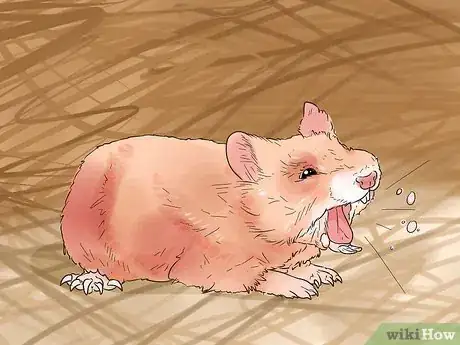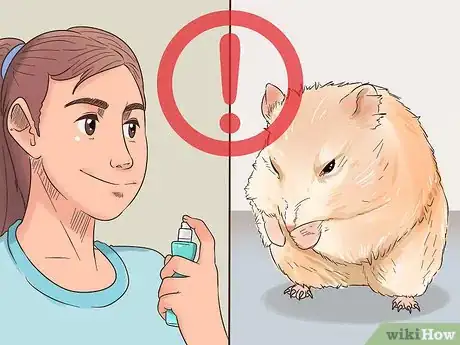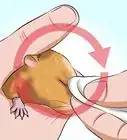This article was co-authored by Pippa Elliott, MRCVS. Dr. Elliott, BVMS, MRCVS is a veterinarian with over 30 years of experience in veterinary surgery and companion animal practice. She graduated from the University of Glasgow in 1987 with a degree in veterinary medicine and surgery. She has worked at the same animal clinic in her hometown for over 20 years.
This article has been viewed 19,565 times.
Hamsters are cute, hearty rodents that are easy to care for and make excellent pets. In some cases, hamsters may develop allergies to their food, bedding, or other environmental allergens. You should always monitor your hamster for any physical signs of an allergic reaction. This is especially important when you are making changes to their environment or food. If you suspect that your hamster is allergic to something, try to identify and remove the allergen. You may need to seek medical attention if the symptoms do not go away within a few days.
Steps
Diagnosing an Allergy
-
1Watch for physical signs of allergies. Hamsters are fairly hearty animals; however, it is possible for them to develop allergies. Typically these allergies are related to food, bedding, or other environmental allergens. To diagnose an allergy in your hamster, watch for physical signs such as:[1]
- Excessive scratching that causes irritation or inflammation of the skin.
- Significant hair loss that is more than regular shedding.
- Sneezing, wheezing, or difficulty breathing.
- Any type of discharge from the nose or eyes.
- Swollen feet.
- Keep in mind that these symptoms can be signs of other health issues. Before you assume your hamster has allergies, take it to the vet to be professionally diagnosed.
-
2Notice if any environmental changes have occurred. If you notice any signs of an allergic reaction in your hamster, you should try to locate the cause of the allergy. Have you made any recent changes to their food, bedding, or environment? These types of changes are likely the cause of the allergy. You should also consider if you have made any changes to your home.
- For example, painting, using a new cleaner, or wearing a new perfume may cause an allergic reaction in your hamster.
Advertisement -
3Monitor your hamster closely when changing their environment. When you make changes to your hamster's environment, it is important that you monitor the hamster closely for signs of allergy. The sooner you find and remove the source of the allergy, the faster the hamster will recover.
Removing Allergens
-
1Find a new type of food. If you believe that food is causing an allergic reaction, then you should switch to a new type of food. Some foods contain food colouring that can cause allergic reactions among hamsters. Similarly, sunflower seeds and peanuts have also been know to cause allergies for hamsters. This type of food should be avoided. Instead, use a natural food.[2]
- Read all food labels and avoid giving your hamster foods that contain any dyes that contain "E" in the number.[3]
- Introduce new treats, such as fruits and vegetables, one at a time so you can easily identify what food is causing an allergic reaction.
-
2Change their bedding. Bedding is a common allergen, especially if you use cedar or pine wood chips. These are very dusty and can contain harsh oils that may irritate your hamster's skin or respiratory tract.[4]
- If you suspect the bedding is the cause of the allergy, then try using a paper-based bedding such as tissues instead.
-
3Place the hamster's cage in a new room. In some cases, your hamster may be allergic to other possible allergens in the room, such as perfumes, cleaners, aerosal sprays, or cigarette smoke. Try moving your hamster’s cage to another room to eliminate some of these possible allergens.[5]
- You may need to do a bit of a trial-and-error to find the source of the allergen. Keep trying though!
Seeking Medical Attention
-
1Monitor the hamster. Once you have identified and removed the potential allergen, monitor your hamster to see if the symptoms clear up. If you have successfully located the allergen, then your hamster should return to normal within 24 hours.[6]
-
2Take the hamster to a vet. If the hamster continues to display physical signs of an allergic reaction after 48 hours, or if the symptoms get worse, then you should take the hamster to the vet. Your hamster may be experiencing a more severe health condition such as a tumor and will require medical attention.[7]
-
3Give antihistamines to the hamster. Your vet may prescribe an antihistamine to help alleviate the symptoms associated with an allergy. Administer the antihistamine as directed by the vet.
Expert Q&A
-
QuestionCan a hamster be allergic to bedding?
 Pippa Elliott, MRCVSDr. Elliott, BVMS, MRCVS is a veterinarian with over 30 years of experience in veterinary surgery and companion animal practice. She graduated from the University of Glasgow in 1987 with a degree in veterinary medicine and surgery. She has worked at the same animal clinic in her hometown for over 20 years.
Pippa Elliott, MRCVSDr. Elliott, BVMS, MRCVS is a veterinarian with over 30 years of experience in veterinary surgery and companion animal practice. She graduated from the University of Glasgow in 1987 with a degree in veterinary medicine and surgery. She has worked at the same animal clinic in her hometown for over 20 years.
Veterinarian Yes, a hamster can be allergic to their bedding. The risk of an allergy is raised if the bedding contains artificial scents or chemicals. Try switching to a different type of bedding and see if the symptoms go away.
Yes, a hamster can be allergic to their bedding. The risk of an allergy is raised if the bedding contains artificial scents or chemicals. Try switching to a different type of bedding and see if the symptoms go away. -
QuestionCan a person be allergic to hamsters?
 Pippa Elliott, MRCVSDr. Elliott, BVMS, MRCVS is a veterinarian with over 30 years of experience in veterinary surgery and companion animal practice. She graduated from the University of Glasgow in 1987 with a degree in veterinary medicine and surgery. She has worked at the same animal clinic in her hometown for over 20 years.
Pippa Elliott, MRCVSDr. Elliott, BVMS, MRCVS is a veterinarian with over 30 years of experience in veterinary surgery and companion animal practice. She graduated from the University of Glasgow in 1987 with a degree in veterinary medicine and surgery. She has worked at the same animal clinic in her hometown for over 20 years.
Veterinarian It's possible to be allergic to anything from pollens to peanuts. We tend to think of cats and dogs as the cause of pet allergies, but in theory, the dander from a hamster has the potential to trigger allergies in those people who are sensitive to them.
It's possible to be allergic to anything from pollens to peanuts. We tend to think of cats and dogs as the cause of pet allergies, but in theory, the dander from a hamster has the potential to trigger allergies in those people who are sensitive to them. -
QuestionAre hamsters good for people with allergies?
 Pippa Elliott, MRCVSDr. Elliott, BVMS, MRCVS is a veterinarian with over 30 years of experience in veterinary surgery and companion animal practice. She graduated from the University of Glasgow in 1987 with a degree in veterinary medicine and surgery. She has worked at the same animal clinic in her hometown for over 20 years.
Pippa Elliott, MRCVSDr. Elliott, BVMS, MRCVS is a veterinarian with over 30 years of experience in veterinary surgery and companion animal practice. She graduated from the University of Glasgow in 1987 with a degree in veterinary medicine and surgery. She has worked at the same animal clinic in her hometown for over 20 years.
Veterinarian People can get allergies to hamsters just as to any animal, be that a cat, dog, or horse. The difference with hamsters is their small size and that they are kept in a relatively small space. This reduces the spread of their dander, which is what usually triggers the allergy.
People can get allergies to hamsters just as to any animal, be that a cat, dog, or horse. The difference with hamsters is their small size and that they are kept in a relatively small space. This reduces the spread of their dander, which is what usually triggers the allergy.
Warnings
- Seek medical attention immediately if the symptoms worsen or the hamster has difficulty breathing.⧼thumbs_response⧽
References
- ↑ http://animals.mom.me/hamsters-allergic-anything-4414.html
- ↑ http://www.netvet.co.uk/hamsters/skin-diseases.htm
- ↑ http://animals.mom.me/hamsters-allergic-anything-4414.html
- ↑ http://animals.mom.me/hamsters-allergic-anything-4414.html
- ↑ http://animals.mom.me/hamsters-allergic-anything-4414.html
- ↑ http://animals.mom.me/hamsters-allergic-anything-4414.html
- ↑ http://animals.mom.me/hamsters-allergic-anything-4414.html




































































